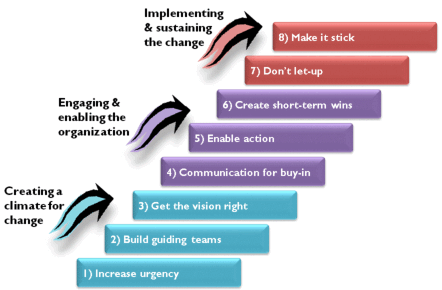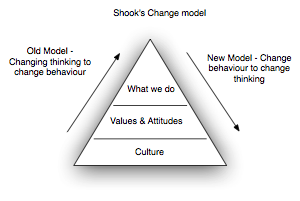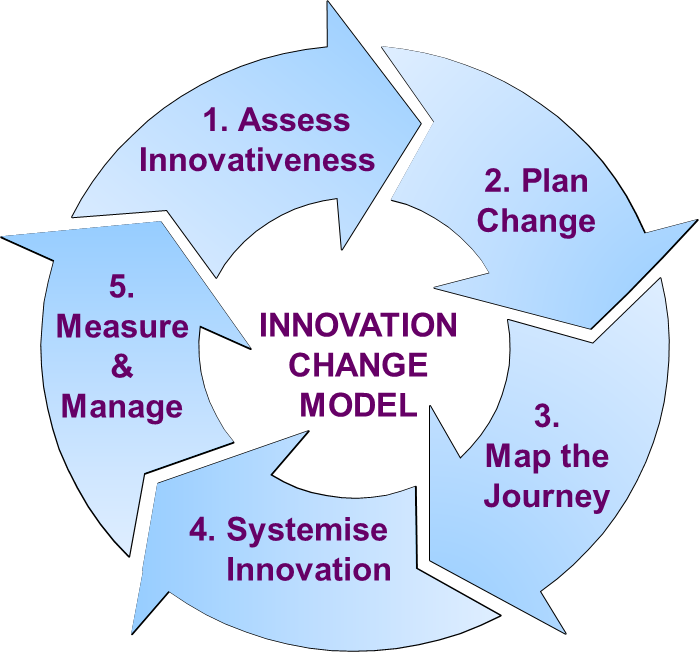Most Significant Errors Made Out of All of the Change Stories and Their Ramifications
The change stories offer an insight into the activities which took place when a number of companies were making significant changes in their structures. In order to understand the errors made in the change processes by the firms reviewed, Kotter’s Model of Change shown in the figure below will be very necessary. The model identifies eight stages of change that should not be ignored when a firm is introducing a new system.

One of the most significant errors made out of the change stories was the inability to restructure the management system after the merger between Hewlett-Packard and Compaq Computer Corporation.
These two companies were performing well and the decision to form a merger was meant to expand their market and efficiency in operations. However, the top managers of the new firm failed to clearly define how various tasks were to be handled. This led to wrangles, overlaps, and in most cases some tasks were not assigned to specific individuals.
The ramification of this mistake is that the operational costs at the new firm increased considerably. Duplication of tasks became common and this reduced the efficiency of the firm. Instead of increasing the market share, this new strategy had almost no significant impact in improving the size of Hewlett-Packard’s market share. The firm was later forced to restructure its human resource which led to massive lay-offs.
Another major error in the stories provided is Kodak’s change strategy from traditional productions to new products. Kodak was known for its traditional films which were popular in the American and European markets. However, the management realized that a time had come for the firm to shift to the digital platform.
The decision to shift to digital photography was not wrong. The major mistake was the strategy used. The shift was too sudden for the stakeholders to withstand, especially the decision to reduce the dividends of the shareholders during the change process.
The ramification of this mistake was a widespread protest by investors who felt that the management of the firm failed to take their interests into consideration. According to Bandler (2003), many investors sold their shares, leading to a massive drop of Kodak’s share prices in the stock market. This mistake led to a consistent deterioration of the firm’s performance which reached its peak when the firm was almost declared bankrupt.
The story about McDonald’s also demonstrates another significant error made during a change process. According to Burrows (2001), when initiating change, it is always necessary to involve all the relevant stakeholders. McDonald’s marketing team failed to keep the public properly informed about the major changes the firm was undertaking to ensure that it offered its customers healthy meals.
The firm also failed to respond to the claims made about the health effects of its products. As Bandler (2004) says, it is critical for a firm to avoid being reactive. Instead, it should predict some of the challenges that may require change and act as may be appropriate.
The ramification of this mistake is that McDonald’s reputation was tainted. The management failed to convince the public that its products are not as dangerous as some people had claimed. The reaction of the firm, especially the sudden change of the menu, only served to confirm to the public that the claims are true.
Hewlett Packard
Recommendations
It is clear from the story of Hewlett Packard that effective consultation was not done prior to the merger. The top managers were in a hurry to seal the merger deal, forgetting the importance of laying proper strategies for the merger. This firm should start by consulting all its stakeholders to come up with a comprehensive solution that is universally acceptable. It should also embrace the best practices from market leaders.
Change image
When implementing the recommended strategy, the directors should consider taking into consideration the change image shown in the figure below. Shook’s Change Model has proven to be effective for firms that find themselves in circumstances such as that of Hewlett Packard.

An alternative strategy to change
As shown in the change image above, when introducing change this firm should ensure that the new methods are in line with the firm’s culture, values, and attitude. During merger, care should be taken to retain the values of the firm as it changes from old to new methods.
IBM
Recommendations
The management of IBM should realize that innovation is not a preserve for the top managers or the most learned. The managers should work with the junior employees in order to come up with new operational strategies at all levels.
Change image
The following change image will be appropriate for the top managers of IBM as they try to promote creativity among the employees. The Innovative Change Model suggests the stages that a firm should follow when coming up with new models.

An alternative strategy to change
IBM should consider having innovation centers at all its major operational centers outside the headquarters. The management should fund these centers to make it possible for its employees to develop their ideas without any challenge. The ideas should be screened before they are applied in various departments.
Kodak
Recommendations
Kodak’s change strategy was too sudden, and it is in this area that the firm will need to adjust. Kodak must realize that change should be a gradual process that cannot be rushed. It should be consistent and should involve all the stakeholders.
Change image
To help the directors at Kodak address their current problems, the following model will be appropriate. According to Hislop (2013), using Kurt Lewin’s change model is always appropriate when a firm is likely to face resistance from the stakeholders.

An alternative strategy to change
The firm should consider using the model shown above in its future change strategies. The model emphasizes on preparing all the stakeholders of the impending changes prior to the actual change process.
McDonald’s
Recommendations
McDonald’s top management will need to restructure its public relations department so that it can be in a better position to handle the external pressure than it is currently doing.
Change image
The top management should consider using Public Relations Model below in its change strategies to help it manage external pressures.

An alternative strategy to change
As shown in the model above, this firm should use multi-media strategy to reach out to the public, especially when faced with pressure from the public. Being reactive will not help. Instead, the firm should consider change as a continuous and gradual process.
References
Adamy, J. (2007). Boss talk: How Jim Skinner flipped McDonald’s. The Wall Street Journal, 1(5), 1-27.
Bandler, J. (2003). Kodak shifts focus from film, betting future on digital lines. The Wall Street Journal, 242(61), 1-4.
Bandler, J. (2004). Ending era, Kodak will stop selling most film cameras. The Wall Street Journal, 243(9), 1-3.
Burrows, P. (2001). Carly’s last stand? The inside story of the infighting at Hewlett-Packard. Business Week, 3763 (24): 43–50.
Certo, S. C. (2010). Supervision: Concepts and skill-building. New York, NY: McGraw-Hill Irwin.
Paton, R. A., & McCalman, J. (2008). Change Management: A Guide to Effective Implementation. London, UK: Sage Publications.
Reiß, M. (2012). Change management: A balanced and blended approach. Mumbai, India: Books on Demand.